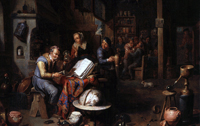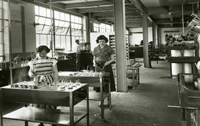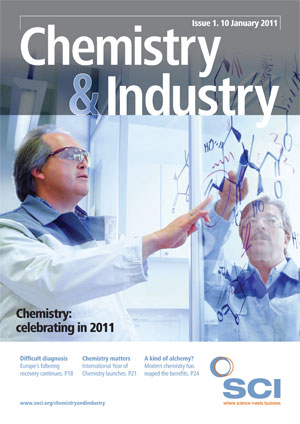Robert Boyle died in London on the last day of December 1691. The 'Father of Modern Chemistry', Boyle was fascinated by alchemy, along with his contemporary Isaac Newton – known even more widely as one of the inventors of calculus and the first modern theory of gravity. Though Newton denied any interest in alchemy in public, he is now known to have written more about alchemy than mathematics and physics put together.
Boyle’s work in defining the experimental aspects of chemistry rests on the work of the alchemists. Although alchemy today is widely regarded as 'mumbo jumbo', the best alchemists used and refined experimental methods that are still part of everyday lab practice around the world – distillation, acid-base reactions, precipitation from solution, and refining of metals, to name just a few of the areas of interest.
The history of chemistry can often look linear and predetermined from the far off future, with alchemy seen as inevitably fading as rational minds saw the superiority of chemistry. Yet history tells a different story: alchemists as skilled experimentalists (Boyle); alchemists as frauds (a few were hanged); alchemists obsessed with secret knowledge (Boyle and Newton); and alchemists as discoverers (Hennig Brandt).
Brandt of Hamburg, a contemporary of Newton and Boyle, while looking for the secret of the Philosopher’s Stone, turned to the ’golden stream‘ of urine as a possible source. A former soldier and apprentice glassmaker who knew how to make hot fires, he boiled the urine down to a dry solid, then heated the residue to a high enough temperature to form glowing fumes, possibly in a glass retort. The vapours – white phosphorus – glowed as they reacted with atmospheric oxygen – a secret that Brandt, in good alchemical fashion, at first kept to himself.
Alchemy’s written origins lie in Hellenistic Greece. Many of chemia’s goals, such as the refining of metals, were purely practical. Early Islamic scholars translated these texts into Arabic, and called their study al-chemia. They studied how matter behaved and changed its form. They improved on older techniques of crystallisation and distillation. And they developed theories on how metals transmuted and how a substance called al-iksir (elixir) might effect this transformation. This al-chemia made its way to Europe in the Middle Ages and a Western tradition in alchemy developed, based on the elixir, which became known as the Philosopher’s Stone.
In the end, what killed alchemy was not its practices, which included medicine, but its reputation. The quest for gold attracted plenty of swindlers and its often secretive nature – if you had the secret of turning lead into gold or even clay into the white gold of porcelain, you kept the knowledge hidden – created a public perception of arcane bumblers and cheaters.

Indeed, Stahl’s championing of phlogiston as the immaterial substance behind combustion remained viable until Antoine Lavoisier’s work on oxygen – evidence perhaps that alchemy was not substantially different to early chemistry. The subtle substance behind heat, the caloric, hung on well into the 19th century. Indeed, that other subtle fluid, the ether, remained a vital part of science until Albert Einstein in 1905 showed science had no need of it.
Since Stahl’s time, chemistry’s focus has both narrowed and grown in power. Another major difference is ‘professionalisation’. While chemists today must still look for funding, Brandt was able to conduct his experiments only because he married a woman with money. After her death at a young age, Brandt remarried, again to a woman with some means: a widow with children by her previous marriage. So Brandt gained a lab assistant in his stepson and more money to fund his research. Six years after discovering phosphorus, Brandt sold the secret for the modern equivalent of several thousand dollars, but his second wife’s income was reported to be much higher than the sale price for the secret – a strong indication that Brandt had wasted the fortunes of both wives with his alchemical quests.
Alchemists and chemists had various motivations – from simply making money to improving the world. In the late 18th century, Joseph Priestley – believer in phlogiston, codiscoverer of oxygen, and creator of the first carbonated beverage – wished to use chemistry as a popular tool for empowerment. Priestley believed that knowledge of the natural world and how it worked would give ordinary people the skills to judge their rulers.
In the wake of the French revolution, this approach did not sit well with the powers that be and some blamed chemistry. Edmund Burke used the language of chemistry to damn the kind of democratic science championed by Priestley. Burke thundered that ‘a hot spirit drawn out of the alembick of hell, which in France is now so furiously boiling’ threatened to cross the Channel and overturn the social order established by nature. He believed that the English faced the same threat as the French, who ‘are delivered over blindly to every projector and adventurer, to every alchymist and empiric.’
Out of that kind of radical chemistry was born the first anaesthetic, nitrous oxide. Humphry Davy survived his early experiments with carbon monoxide and in 1799 went on to experiment with nitrous oxide and its possible healing powers. He soon became aware of its power to lessen pain and even cause unconsciousness. But what people remembered was the ridiculous behaviour – laughter, dancing, and general silliness – that often accompanied inhalation of the gas and nitrous oxide developed a mildly scandalous reputation. Not until 1844 was it actually used in surgery, for a tooth extraction.
Ether soon took centre stage, first used in England in 1846, in the same city in which Davy carried out his experiments with nitrous oxide. Ether, followed by chloroform, quickly changed the practice of surgery. Before ether, every patient faced a choice between the pain and danger of the illness or injury and the literal torture of the cure.
But after the initial passions cooled and anaesthesia began to be an expected part of surgery, medical professionals began to consider the very real risk involved in being put into an artificial sleep. The greatest risk was that the patient in the anaesthetic-induced sleep would never wake up. Anaesthetic death was rare even in the 1840s, but it did happen and every surgical patient had to consider that possibility. Should the patient be anaesthetised for a tooth extraction? Whatever our attitudes today, this chemical conquest of pain at a time when surgery was still a bloody, messy, and often deadly experience for the patient, must remain one of the high points of chemistry.
In 1856, William Henry Perkin synthesised mauve dye from coal tar while trying to make artificial quinine. Priestley had hoped to use chemistry to help the medical lot of poor people; Perkin now made bright cloth available to all people, not just the rich. The products of chemistry were becoming an everyday experience for people of all social classes.
Perkin’s coal-tar source material became the basis for the fledgling drug industry. Flavours and fragrances could also be created from coal tar and other organic materials thought to be little more than waste. To this day, a plant in Jacksonville, Florida, built at the turn of the 20th century, makes dozens of flavours and fragrances from one source material – crude sulphate turpentine. This foul effluent of Georgia paper mills is turned into pine oil, liquorice, floral scents, citrus, and menthols. Chemists were transmuting waste into brilliant colours and luscious scents.
In France, a young chemist named Louis Pasteur got into hot water with one of the preeminent chemists of the day, Justus Leibig, for putting life back into matter, specifically fermentation, just when chemists had managed to get rid of the idea of a vital principle of life. From fermentation to germs was a short step and Pasteur went on to put the germ theory on a solid footing. In his own lifetime, he became the first scientist to achieve superstardom, in the 1880s with his rabies vaccine. Rabies, a fatal disease that caused a fear far out of proportion to the number of people it killed, terrified with its uncertainty. Patients came from as far away as Russia and the US to receive treatment after being bitten. A grateful world showered enough money on Pasteur to enable him to create the Pasteur Institute, still a leader in infectious diseases. Incidentally, Pasteur’s approach boosted the prestige of laboratory science in medicine, then still ruled by doctors at the bedside.

Too many ironies surround this story to include them all. Before Haber’s discovery, the best predictions capped world population at between 1.5 and 2bn. With the Haber-Bosch process, world population is passing six billion and fertiliser is not the limiting factor. Later, in 1915, Captain Fritz Haber of the Kaiser’s army personally supervised the first large-scale use of gas warfare in Ypres, Belgium. Haber was a patriot who thought gas warfare would bring a quick end to the war. It didn’t. Haber, a Jew, lived just long enough to be exiled by the Nazis in 1933, the year of his death.
From the high of feeding the world to the low of gas warfare, chemistry’s power to transmute matter has grown to a degree the alchemists of old could not even dream of. Broad spectrum antibiotics, nylon, DNA, microchips – Gordon Moore, cofounder of Intel Corporation, said semiconductors are a ‘chemical industry’ – and biotech 'are all in that mix in which we must also include explosives, pollution and the atomic bomb'. Chemistry has always been a servant to human desires, for good and for ill. Alchemical history is our history, part of the long history that brought us from cooking meat over fire to creating products from the modest to the miraculous. Those outside the modern world of chemistry and its industry tend to see chemistry as the science that makes stuff, lacking the grandeur of physics and its theories and biology’s compelling narrative of life.
Chemistry does not have a public history in the same way as do the other disciplines, indeed up until the 17th century chemistry did not have a high social status – it was the province of the practical and the artisanal and had no place in the university. But chemists should take pride in their ancestry, without which the modern world would be a much poorer place.
Neil Gussman is strategic communications manager at the Chemical Heritage Foundation, Philadelphia, US.





